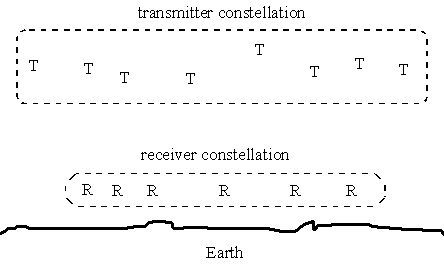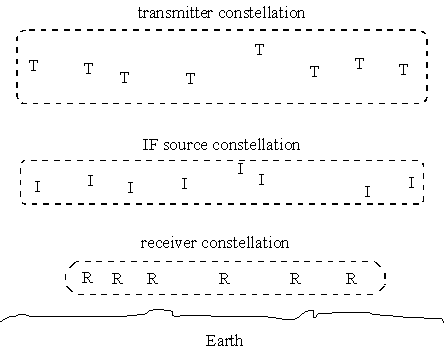Identifying components of the CommSystem consists of:
- Organizing groups of transmitters, receivers, and radars into constellations.
- Selecting constellations to carry out the transmit and receive functions in the system. Use the CommSystem's Basic Transmit page to select one or more constellations to carry out the transmit function in the communications link analysis. Use the CommSystem's Basic Receive page to select constellations to carry out the receive function in the CommSystem.
- Assigning one or more constellations the role of interference sources, if needed. Use the CommSystem's Basic IF Sources page to select one or more constellations of transmitters and/or radars to function as potential interference sources.
To select a constellation, highlight it under Available Constellations and either double-click it or click the right arrow (![]() ). To de-select a constellation, highlight it under Selected Constellations and double-click it or click the left arrow (
). To de-select a constellation, highlight it under Selected Constellations and double-click it or click the left arrow (![]() ). If the constellation contains invalid objects, you will be informed of that when you click OK or Apply.
). If the constellation contains invalid objects, you will be informed of that when you click OK or Apply.
If the selected constellation for the Receive function contains only Simple model receivers, you will receive a warning that interference may not be calculated correctly.
Example of a CommSystem
The following figure represents an elementary CommSystem, consisting of a constellation of space-based (or air-based) transmitters and a constellation of Earth-based receivers. Many other configurations, including the direct opposite of the one shown here, are possible.

A basic CommSystem
Example of a CommSystem with Interference Source
The following figure represents a simple case of a CommSystem including transmitters identified as an interference source:

Basic Comm system with interference source
Again, numerous configurations are possible; for example, it is not necessary for the interference source constellation to be positioned "between" the transmitter and receiver constellations. You can also use CommSystems to analyze a dynamic configuration of links in constellations of transmitters and receivers, without any interference constellation.